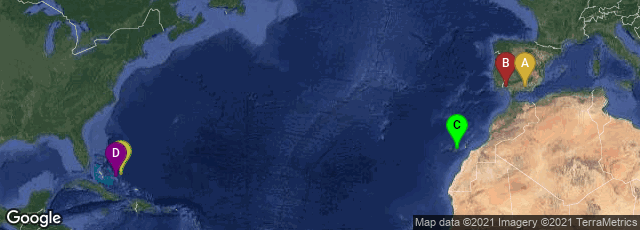
A: Pulianas, Andalucía, Spain, B: Palos de la Frontera, Andalucía, Spain, C: Spain, D: (23.74,-75.370003), E: San Salvador, The Bahamas
Portrait of a man, said to be Christopher Columbus by No demonstably authentic portraits of Columbus exist. Metropolitan Museum of Art.
"In the same month in which their Majesties [Ferdinand and Isabella] issued the edict that all Jews should be driven out of the kingdom and its territories, in the same month they gave me the order to undertake with sufficient men my expedition of discovery to the Indies."
So begins the diary of Christopher Columbus (Cristoforo Colombo; Cristóbal Colón; Cristóvão Colombo). The expulsion to which Columbus refers was almost as important in Jewish history as the Voyage of Columbus was in American history. Following the terms of the Edict of Expulsion, or Alhambra Decree, on July 31, 1492 those Jews who did not convert to Christianity were expelled from Spain. Estimates of the number of Jews expelled range from 130,000 to 800,000. It is thought that Jews represented at least 10% of the population of Spain before the expulsion. Some of the expelled Jews were accepted in Holland, and some in Italy, but most settled in the Ottoman Empire or in Africa.
"On the evening of August 3, 1492, Columbus departed from Palos de la Frontera with three ships; one larger carrack, Santa María, nicknamed Gallega (the Galician), and two smaller caravels, Pinta (the Painted) and Santa Clara, nicknamed Niña after her owner Juan Niño of Moguer. They were property of Juan de la Cosa and the Pinzón brothers (Martín Alonso and Vicente Yáñez), but the monarchs forced the Palos inhabitants to contribute to the expedition. Columbus first sailed to the Canary Islands, which were owned by Castile, where he restocked the provisions and made repairs. On September 6, he departed San Sebastián de la Gomera for what turned out to be a five-week voyage across the ocean" (Wikipedia article on Christopher Columbus, accessed 01-10-2008).
At 2 AM on October 12, 1492 a sailor aboard the Pinta named Rodrigo de Triana (Juan Rodríguez Bermejo) sighted land in the New World. This was an island in the Lucayan Archipelago of the Bahamas called by the natives Guanahani, which Columbus named San Salvador.
"Exactly which island in the Bahamas this corresponds to is unresolved. Prime candidates are Samana Cay, Plana Cays, or San Salvador Island (so named in 1925 in the belief that it was Columbus's San Salvador)" (Wikipedia article on Christopher Columbus, accessed 01-03-2013).